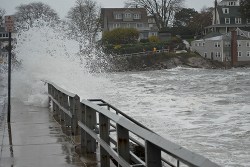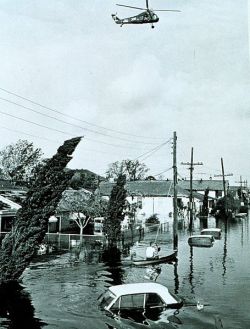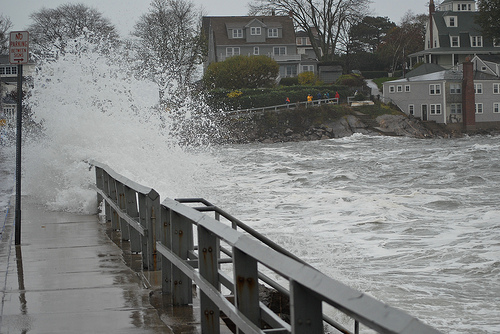
Brian BirkeHurricane Sandy batters Massachusetts. Levees and seawalls alone won’t protect us from the next big one.
Hurricane Sandy caused unprecedented flooding in Lower Manhattan and coastal New Jersey, as a larger-than-expected tidal surge washed over the area. In the aftermath, New York Gov. Andrew Cuomo (D) and New York City Mayor Michael Bloomberg (I) said that we will need to address the challenges of climate change and rising sea levels, in part, by building levees and structural storm protection systems. The city’s future might depend upon structural defense systems to keep the Atlantic Ocean from inundating low-lying New York City.
The temptation to build levees, storm walls, and sea gates and to deploy other technological solutions to the problem will be very tempting. It seems obvious that in the face of flood risks, structural barriers and sophisticated pumping systems are key to a city’s safety. However, the history of such technologies suggests they are not without peril and have the potential to increase risk and vulnerability.
The history of New Orleans’ levee and pumping system provides us an historical example of how such systems can exacerbate flooding and increase vulnerability among the urban inhabitants. During the post-World War II boom years of urbanization, New Orleans city builders drained swamps, extended the city’s pumping capacity, and built out the levee system to nearly encircle the city and a few of the surrounding urbanizing areas. As a result, whole new suburban neighborhoods were made possible, sitting on top of what was once swamp and marsh ecosystems, the barrier between the city and the Gulf of Mexico.

National Oceanic and Atmospheric AdministrationFlooding in New Orleans’ Lower Ninth Ward after Hurricane Betsy.
In 1965, Hurricane Betsy, a large and powerful storm, tested the New Orleans levee system. The system failed in many places, as storm surges burst levees and put large portions of the city (the old swamp and marsh lands) underwater, including the now famous Lower Ninth Ward. After the failure, what did city builders do? They doubled down on the technological fix and built even more subdivisions in the city (e.g. New Orleans East, which was four feet underwater during Betsy). So enamored by technology, the promise of modernity, the solution after Betsy was more levees, higher levees, and more technological solutions overall. Less emphasis was put on other aspects of disaster mitigation and preparation.
As a consequence, 40 years later, Hurricane Katrina exposed the weaknesses of the human-made protection system. The levee system failed again, and resulted in massive devastation to the city and to human life. Katrina also exposed the weaknesses of the non-structural mitigation and preparation plans. This is the lesson for New York City, and all other areas experiencing social and ecological disaster.
Technological solutions can only be one part of a mitigation and preparation strategy. Moreover, technological solutions can end up causing even more damage, risk, and vulnerability, when people build into riskier landscapes and come to believe in the safety of these grand technological systems, which often live up to their Promethean qualities and contain embedded unintended consequences.
There are vast differences between New Orleans and New York, yet some basic lessons in crisis mitigation are worth remembering. New York City, and the coastal and highly urbanized Northeast, will need to consider a wide range of mitigation and preparation strategies if hurricanes become an increasing aspect of their socioecology:
One, structural solutions will factor into the mix, whether it’s sea walls, sea gates, or pumping systems. People cannot, however, be lulled into the comfort these systems provide, and must work on a number of other solutions.
Two, policymakers and an engaged public will need to craft detailed pre- and post-storm response plans, something that was missing in New Orleans, and resulted in scenes such as the infamous Superdome “shelter of last resort.” Pre- and post-storm strategies refer to plans about evacuating and moving people out of harm’s way. Mandatory, everybody-for-themselves evacuations are not good enough, and may cause more harm. Detailed urban evacuations are complex, but essential. Post-storm planning requires coordinating first responders, emergency services, and functioning governance frameworks, so as to minimize confusion and the breakdown of services.
Three, policy makers and an engaged public will need to address long-term social and environmental inequalities — what is called social vulnerability. The geography of poverty often matches the geography of risk. People’s capacity to prepare for a storm is shaped by these factors, but so is people’s capacity to rebuild and bounce back after a crisis — what is called resilience. It is not just about money and incomes, it is also about strong communities and participatory risk assessment and planning.
Four, addressing climate change as a long-term project will be essential. At the present rate, sea levels will continue to rise, so decisions on climate change made today could address vulnerability and risk in 50 to 100 years’ time. Addressing climate change is not going to make cities and communities safer anytime soon.
Therefore, a focus on climate change, although important, doesn’t address the urgent needs of vulnerable communities, and whole cities and towns, in the immediate future. That is why a mix of structural systems, a reduction of environmental inequalities and vulnerabilities, and community empowerment and participation in disaster planning and mitigation are most pressing. Technology alone will not save us, and it may make cities and their inhabitants more vulnerable to ecological crises.


